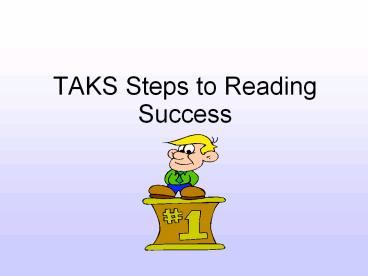TAKS Steps to Reading Success - PowerPoint PPT Presentation
1 / 29
Title:
TAKS Steps to Reading Success
Description:
TAKS Steps to Reading Success Preview each ... Make a prediction Make a connection Visualize Retell Ask a question Evaluate Read the selection carefully and ... – PowerPoint PPT presentation
Number of Views:210
Avg rating:3.0/5.0
Title: TAKS Steps to Reading Success
1
TAKS Steps to Reading Success
2
Preview each selection. Read the first
paragraph and the last paragraph, titles,
subtitles, pictures, etc.
Key words, bold print, italicized words, CAPITAL
LETTERS and punctuation are all used to enhance
understanding.
3
Read All Directions
4
First, do the selection which looks the least
interesting because you are fresher.
5
Do the paired selections next.
6
Read the selection carefully and pause after each
paragraph to respond to the text. Think about
the following strategies
- Make a prediction
- Make a connection
- Visualize
- Retell
- Ask a question
- Evaluate
7
Make a Prediction!
8
Make a Prediction
I anticipate whats coming next. Based on what
Ive read, I expect certain new events to occur.
When an event doesnt match a prediction, I
rethink and revise my thinking.
9
Make a Connection!
10
Make a Connection
- Make a connection between the text and
- my life
- my knowledge of the world
- another text
11
Visualize!
12
Visualize
I consciously create images in my head helping me
to make sense of what the words are saying. I
can use MOVIES, TELEVISION, and LIFE to help me
picture what is happening. Images help me make a
video in my head. If I can see it, I often
understand it.
13
Retell!
14
Retell What Ive Read
Asking What have I just read? refreshes my
memory and prepares me to read the next part .
Writing down what Ive read allows me to clarify
my thinking.
15
Ask a Question!
16
Ask a Question and Try to Answer It
I ask myself questions when I read. Sometimes
these questions are answered directly in the text
and meaning is clarified. They ask who,
what, when and where. Right There
17
Ask a Question and Try to Answer It
Other times, answers to my questions arent found
in the text. These are pondering questions that
dont always have simple answers. They ask how
and why. In these cases, I am forced to go
beyond the words to find the answer. Author and Me
18
Evaluate!
19
Evaluate
Form opinions about what you read, both while
youre reading and after youve finished.
Develop your own ideas about characters and
events.
20
What Else Can I Do?
21
Read each question carefully. Underline or
highlight the clue words in the question.
22
Answer from the point of view
of the author writing the selection.
23
Use CLUES AND EVIDENCE from the passage when
answering the question.
24
Before any answer, read
the question again and then the answer to see if
it sounds right and makes sense based on what you
read. Prove your answer with evidence from the
text.
25
GO BACK AND REREAD!! YOU HAVE
26
Stop and Think
Stop and think about what Ive already read.
I connect newly acquired knowledge with
information I already have.
STOPPING AND THINKING gives me time to synthesize
new information.
27
Use the process of elimination make a
single line through the answers you think are
.
28
Make an educated guess based on clues and
evidence in the passage.
29
Circle Bubble Check

